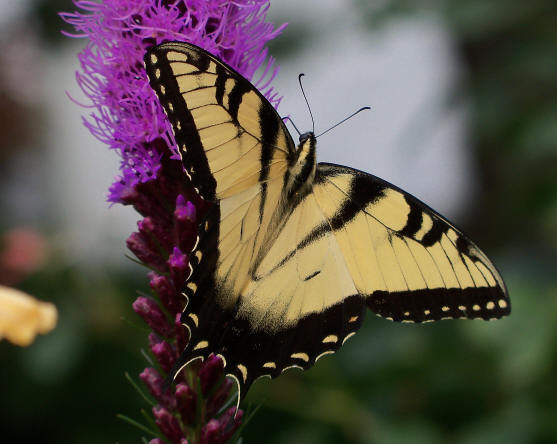
Butterflies are a beneficial pollinator. People love to watch them in their gardens because of their delicate beauty. Once you experience them coming into your garden, you may also begin to wonder what happens to them in the wintertime.
Most butterflies are "residents" which means they winter over right in your garden. Some, like the famous monarchs, migrate to warmer climates. The Monarchs go all the way to Mexico, but many migrating species go only as far as the Carolinas. A few of our very common butterflies that migrate are the Cloudless Sulphur, Painted Lady, Red Admiral,
and the Common Buckeye. There are more than one hundred species of butterflies that have been reported in Pennsylvania, but exactly which ones you may see depends on the habitat needs of that species, and what your property has to offer.
Almost everyone is familiar with the monarch butterfly. Its beauty is unsurpassed in the butterfly world. In recent years they have attracted a lot of attention because they are endangered. Their single host plant, Milkweed, is systematically being destroyed by the "progress" of modern civilization. Since the monarch caterpillar can survive on
nothing but milkweed, and most people don't want Common Milkweed growing in their lawn, the monarch numbers have been diminishing at an alarming rate. Today, savvy gardeners are providing a section of Asclepius (milkweed) in their ornamental gardens, and also discovering Butterfly Weed, a very attractive member of the Asclepias family.
Almost every school child can relate the story of how the monarch lays her eggs on the leaf of the milkweed plant. The egg hatches and the caterpillar (larva) eats the leaves of the milkweed. It then forms it's chrysalis (pupa) which hangs by a thread until the adult butterfly emerges.
Every butterfly species will go through the same life cycle. What changes is the host plants that enable them to survive, and the form in which they survive the winter.
Our beautiful and very common Eastern Swallowtail butterfly is a resident. It goes through the same stages of metamorphosis - egg - caterpillar - chrysalis - butterfly, but it does not migrate. Shortly after it emerges from its chrysalis, it will mate, lay its eggs, and the cycle will begin again.

The Swallowtails may repeat this cycle at least two times during the season. As fall days become colder, any chrysalis will simply remain and the pupa within it will hibernate. Adult swallowtails will die in the cold weather, but the hibernating pupae will emerge from the chrysalis in spring.
Unlike the monarch, the eastern swallowtail will accept a variety of different host plants, most of which are trees such as Yellow Poplar, Black Willow, Black Cherry, American Hornbeam, Red Maple, Spicebush, American Elm, and Sassafras. Because it can accept all these different host plants, the Eastern Swallowtail is not a threatened species. In
the wintertime, a very close examination of one of these trees, may reveal a half inch long chrysalis clinging closely to the bark or tucked into some small crevice of the trunk. Here, it will stay until spring unless it is discovered and eaten by a woodpecker, crow, nuthatch, squirrel, or owl.
A close cousin of the eastern swallowtail is the black swallowtail. It looks very much like its cousin with the characteristic two tails, except it is black with some attractive blue dots across its lower wings. The host plants of the black swallowtail are members of the carrot family, especially dill, parsley, and fennel. When the cold weather
approaches, the black swallowtail butterfly attaches its chrysalis to a stick, a heavy stalk, or even the foundation of a building.
Some butterflies, such as the Eastern Tailed Blue, winter over as caterpillars. The Tailed Blue is a small butterfly which you may not have noticed because it tends to rest with its wings up, hiding the blue on the wings' upper side. It has a thread-like tail. This little butterfly uses clover and members of the legume family as host plants, and
winters over as a tiny caterpillar hiding in the leaf cover near its host.
The Viceroy also winters over as a caterpillar. The viceroy is a monarch look-alike, but slightly smaller. You have to look closely to notice the difference because their markings are almost identical. For a host plant, the Viceroy prefers a willow, or a poplar tree. In the fall, the very tiny caterpillar, which looks like bird poop, wraps itself
in a leaf of one of its hosts, and falls with it to the ground where it remains for the winter. If you own one of these trees and would like to see Viceroys in your yard, think about this when you decide to rake or burn leaves.
The mourning cloak is an example of a butterfly that can actually hibernate in it's adult form. It will crawl inside the crevice of a tree trunk or get under some loose bark to spend the winter. It is often called the butterfly harbinger of spring, since it emerges in its adult form and can be seen flying around on early, warm spring days. It is a
large, dark maroon butterfly with ragged, cream colored edges on its wings. You may see it drinking the sap of oak trees, or sipping in mud puddles or animal manure.
Learning about the life of these beneficial insects can be very exciting and interesting. It provides a great example of the wonderful and diverse gifts from nature.
Read other articles on birds, wildlife & beneficial insects
Read other winter related gardening articles
Read other articles by Barbara Mrgich